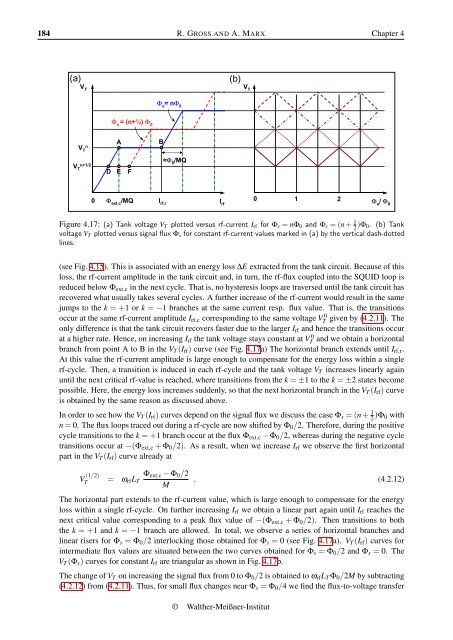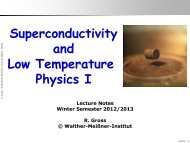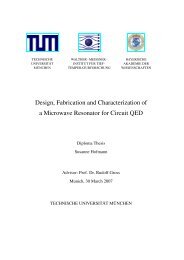Applied Superconductivity - Walther Meißner Institut - Bayerische ...
Applied Superconductivity - Walther Meißner Institut - Bayerische ...
Applied Superconductivity - Walther Meißner Institut - Bayerische ...
- No tags were found...
You also want an ePaper? Increase the reach of your titles
YUMPU automatically turns print PDFs into web optimized ePapers that Google loves.
184 R. GROSS AND A. MARX Chapter 4(a)(b)V TV TA BΦ s= (n+½) Φ 0Φ s= nΦ 0V TnV Tn+1/2D E F≈Φ 0/MQ0 Φ ext,c/MQ0 1 2I rf,rI rfΦ s/ Φ 0Figure 4.17: (a) Tank voltage V T plotted versus rf-current I rf for Φ s = nΦ 0 and Φ s = (n + 1 2 )Φ 0. (b) Tankvoltage V T plotted versus signal flux Φ s for constant rf-current values marked in (a) by the vertical dash-dottedlines.(see Fig. 4.15). This is associated with an energy loss ∆E extracted from the tank circuit. Because of thisloss, the rf-current amplitude in the tank circuit and, in turn, the rf-flux coupled into the SQUID loop isreduced below Φ ext,c in the next cycle. That is, no hysteresis loops are traversed until the tank circuit hasrecovered what usually takes several cycles. A further increase of the rf-current would result in the samejumps to the k = +1 or k = −1 branches at the same current resp. flux value. That is, the transitionsoccur at the same rf-current amplitude I rf,c corresponding to the same voltage VT 0 given by (4.2.11). Theonly difference is that the tank circuit recovers faster due to the larger I rf and hence the transitions occurat a higher rate. Hence, on increasing I rf the tank voltage stays constant at VT 0 and we obtain a horizontalbranch from point A to B in the V T (I rf ) curve (see Fig. 4.17a) The horizontal branch extends until I rf,r .At this value the rf-current amplitude is large enough to compensate for the energy loss within a singlerf-cycle. Then, a transition is induced in each rf-cycle and the tank voltage V T increases linearly againuntil the next critical rf-value is reached, where transitions from the k = ±1 to the k = ±2 states becomepossible. Here, the energy loss increases suddenly, so that the next horizontal branch in the V T (I rf ) curveis obtained by the same reason as discussed above.In order to see how the V T (I rf ) curves depend on the signal flux we discuss the case Φ s = (n+ 1 2 )Φ 0 withn = 0. The flux loops traced out during a rf-cycle are now shifted by Φ 0 /2. Therefore, during the positivecycle transitions to the k = +1 branch occur at the flux Φ ext,c − Φ 0 /2, whereas during the negative cycletransitions occur at −(Φ ext,c + Φ 0 /2). As a result, when we increase I rf we observe the first horizontalpart in the V T (I rf ) curve already atV (1/2)T = ω rf L TΦ ext,c − Φ 0 /2M. (4.2.12)The horizontal part extends to the rf-current value, which is large enough to compensate for the energyloss within a single rf-cycle. On further increasing I rf we obtain a linear part again until I rf reaches thenext critical value corresponding to a peak flux value of −(Φ ext,c + Φ 0 /2). Then transitions to boththe k = +1 and k = −1 branch are allowed. In total, we observe a series of horizontal branches andlinear risers for Φ s = Φ 0 /2 interlocking those obtained for Φ s = 0 (see Fig. 4.17a). V T (I rf ) curves forintermediate flux values are situated between the two curves obtained for Φ s = Φ 0 /2 and Φ s = 0. TheV T (Φ s ) curves for constant I rf are triangular as shown in Fig. 4.17b.The change of V T on increasing the signal flux from 0 to Φ 0 /2 is obtained to ω rf L T Φ 0 /2M by subtracting(4.2.12) from (4.2.11). Thus, for small flux changes near Φ s = Φ 0 /4 we find the flux-to-voltage transfer© <strong>Walther</strong>-Meißner-<strong>Institut</strong>
















